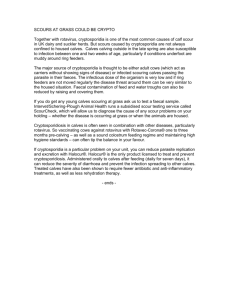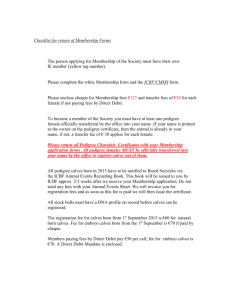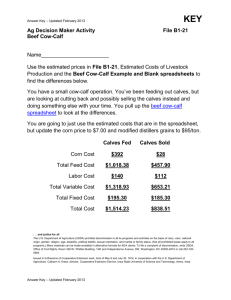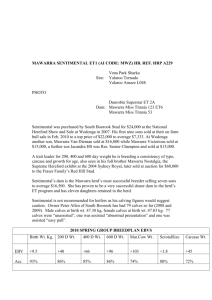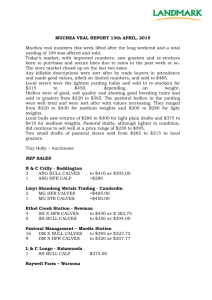cefoperazone pharmacokinetics following singleintravenous
advertisement
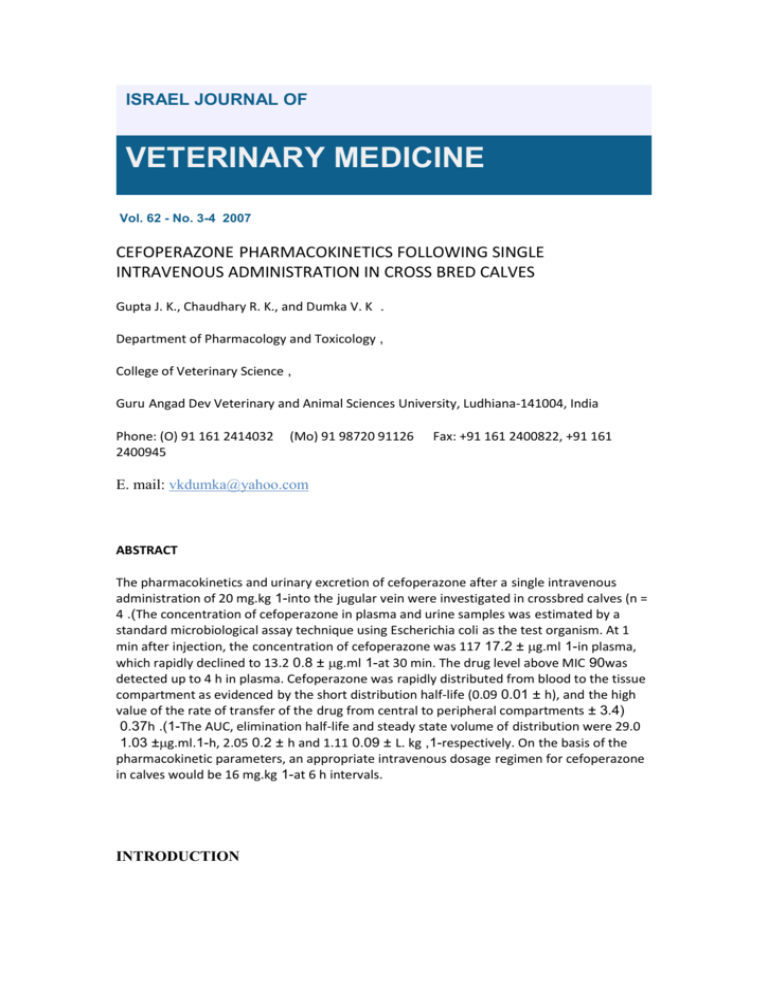
ISRAEL JOURNAL OF VETERINARY MEDICINE Vol. 62 - No. 3-4 2007 CEFOPERAZONE PHARMACOKINETICS FOLLOWING SINGLE INTRAVENOUS ADMINISTRATION IN CROSS BRED CALVES Gupta J. K., Chaudhary R. K., and Dumka V. K . Department of Pharmacology and Toxicology , College of Veterinary Science , Guru Angad Dev Veterinary and Animal Sciences University, Ludhiana-141004, India Phone: (O) 91 161 2414032 2400945 (Mo) 91 98720 91126 Fax: +91 161 2400822, +91 161 E. mail: vkdumka@yahoo.com ABSTRACT The pharmacokinetics and urinary excretion of cefoperazone after a single intravenous administration of 20 mg.kg 1-into the jugular vein were investigated in crossbred calves (n = 4 .)The concentration of cefoperazone in plasma and urine samples was estimated by a standard microbiological assay technique using Escherichia coli as the test organism. At 1 min after injection, the concentration of cefoperazone was 117 1..1 ± g.ml 1-in plasma, which rapidly declined to 13.2 8.0 ± g.ml 1-at 30 min. The drug level above MIC 08was detected up to 4 h in plasma. Cefoperazone was rapidly distributed from blood to the tissue compartment as evidenced by the short distribution half-life (0.09 8.81 ± h), and the high value of the rate of transfer of the drug from central to peripheral compartments ± 4.3( 8.4.h .)1-The AUC, elimination half-life and steady state volume of distribution were 29.0 1.84 ±g.ml.1-h, 2.05 8.1 ± h and 1.11 8.80 ± L. kg ,1-respectively. On the basis of the pharmacokinetic parameters, an appropriate intravenous dosage regimen for cefoperazone in calves would be 16 mg.kg 1-at 6 h intervals. INTRODUCTION Cefoperazone, a third generation cephalosporin, possesses broad spectrum activity against gram-positive, gram-negative and anaerobic bacteria including H. influenza Neisseria meningitides and Streptococcus pneumoniae. Clinical studies have demonstrated cefoperazone to be a valuable drug in the treatment of calf diseases such as diarrhoea and pneumonia associated with gram-negative bacteria resistant to many commonly used antibiotics (1). Cefoperazone is suitable for the treatment of bone and joint infections of horses (2), intensive care infections of humans (3) and has good penetration into the pancreas indicating its usefulness in the prophylaxis and therapy of secondary pancreatic infections (4). The pharmacokinetics of cefoperazone have been determined in unweaned calves (5), buffalo calves (6, 7), horse (8), sheep (9) and humans (10). However, such information is lacking in calves. Awareness of the marked species variation in antimicrobial drugs kinetics, the present study was undertaken to determine the pharmacokinetics, urinary excretion and an appropriate dosage regimen after a single intravenous administration of cefoperazone in cross bred calves. MATERIALS AND METHODS Experimental animals and drug administration The study was conducted on 4 healthy male crossbred calves (Holstein Friesian x Sahiwal), about one year old and weighing between 88-120 kg. The animals were kept in the departmental animal shed under standard conditions of management for 2 weeks prior to the commencement of the study and were provided green fodder and water ad libitum. All the animals were healthy at the time of experimentation. The experimental protocol followed the ethical guidelines on the proper care and use of animals. Cefoperazone (Panacea Biotech Ltd., India) was administered into the left jugular vein at a dose rate of 20 mg.kg body weight as a freshly prepared 20 % solution. The dose of the drug employed in the present study was comparable to the doses used in other species of animals by previous workers. Blood and urine sampling The animals were kept in metabolic stalls of standard size. Blood samples (5 ml) were withdrawn from the contralateral jugular vein into heparinized glass centrifuge tubes before and at 1, 2.5, 5, 7.5, 10, 15, 30, 45 min and 1, 1.5, 2, 2.5, 3, 4, 5, 6, 8, 10 and 12 h after administration of drug. Plasma was separated by centrifugation at 1300 g for 15 min at room temperature and kept at -200C until analysis, which was done usually on the following day. Urine samples were also collected from the animals at predetermined time intervals of 2, 4, 6, 8, 10, 12, 18 and 24 h after administration of drug. The metabolic stalls were designed so that urine excreted naturally by the animals within a period was automatically collected without contamination or spillage in the containers placed beneath the stalls. At the end of the given time interval, the volume of total urine voided and collected in the container was measured for each animal, and 5 ml samples were taken for analysis after filtration. Analytical procedure The concentration of cefoperazone in plasma and urine samples was estimated by a standard microbiological assay technique (11) using Escherichia coli (ATCC 10536) as the test organism. The assay plates were incubated at 370C for 12 h. At the end of incubation, the diameter of zone of inhibition of each well was measured with a Fisher Lilly Antibiotic Zone Reader (Fisher Scientific Company USA). For each sample, 9 replicates were analysed and compared with the zone of inhibition of a standard reference solution of cefoperazone (0.3 µg.ml-1). The concentration of cefoperazone in the samples was calculated as µg.ml-1 of plasma or urine. The assay could detect a minimum of 0.25 µg.ml-1 of cefoperazone without differentiating between the parent drug and its metabolites. Calculation of pharmacokinetic parameters Pharmacokinetic parameters were calculated manually by the computed least-squares linear regression technique by applying compartmental analysis (12). The mean pharmacokinetic variables were obtained by averaging the variables calculated for drug disposition after intravenous drug administration to each animal. RESULTS The mean plasma levels of cefoperazone in crossbred calves, at various time intervals, after its single intravenous administration (20 mg.kg-1) are presented on a semilogarithmic scale in Figure 1. At 1 min, the mean plasma drug concentration was 117 ± 17.2 µg.ml-1 which rapidly declined to 13.2 ± 0.8 µg.ml-1 at 30 min. Evaluation of the results revealed that the disposition pattern of cefoperazone was adequately described by the bi-exponential equation: Cp = Ae-αt + Be-βt, where, Cp is the plasma level of cefoperazone at time t and e represents the base of natural logarithm. A and B are the extrapolated zero-time intercepts of the distribution and elimination phases, respectively. α and β are the rate constants of distribution and elimination phases, respectively. The pharmacokinetic parameters that describe the distribution and elimination pattern of cefoperazone in calves were calculated manually and presented in Table 1. Using a convenient dosage interval and the values of β and Vdarea from Table 1, the priming (D) and maintenance (D') doses of cefoperazone were calculated from following equations: D = Cpmin∝.Vd (eβτ), D' = Cpmin∝.Vd (eβτ-1), where Cpmin∝ is the MIC of cefoperazone, β is the elimination rate constant and τ is the dosing interval (13). Table 1. Pharmacokinetic parameters of cefoperazone in crossbred calves (n=4) following a single intravenous dose of 4 mg. kg-1 body weight Cp0 = plasma drug concentration at time zero after intravenous dose; A and B = the zero time intercepts of distribution and elimination phases, respectively; t1/2α = distribution half life; K12 and K21 are rate constants of drug transfer from central to peripheral and from peripheral to central compartment, respectively; P/C = ratio of drug in peripheral to central compartment; AUC = area under the plasmaconcentration time curve; AUMC = area under the first moment of plasmaconcentration time curve; Vd(ss) = steady-state volume of distribution; ClB = total body clearance of drug; MRT = mean residence time; t1/2β = elimination half life Fig.1 Semilogarithmic plot of plasma concentration-time profile of cefoperazone following a single intravenous injection of 20 mg.kg-1 body weight in crossbred calves. Values are presented as mean ± SE of 4 animals. The data was analysed according to two-compartment open model. Distribution (α) and elimination (β) phases are represented by least square regression lines. The calculated points (o) of distribution phase were obtained by feathering technique. DISCUSSION The pharmacokinetics of cefoperazone following intravenous administration in crossbred calves was best described by the two compartment open model. In accordance to our findings, the disposition curve of cefoperazone in unweaned calves (5) was reported to follow a two compartment open model. However, in buffalo calves after intravenous administration it followed a three compartment open model (6), and in man (14). In the present investigation, the drug was detected in plasma up to 8 h after dosing (0.57 ± 0.01 µg.ml-1). In contrast to the findings of this study, low peak plasma levels of cefoperazone (57.3 µg.ml-1) were reported in unweaned calves (5) and the drug was detected up to 10 h, whereas peak plasma levels of 86.9 µg.ml-1 were reported following intravenous administration of cefoperazone in buffalo calves and the drug was present up to 24 h (6). The plasma level of ≥ 0.2 µg.ml-1 for third generation cephalosporins is considered adequate against most species of sensitive bacteria including enterobacteriaceae spp. (15). However, a plasma concentration of 0.25-2.0 µg.ml-1 has been reported as the minimum therapeutic concentration (MIC90) of cephalosporins against common animal pathogens (16). In this discussion, an average value of MIC (1.0 µg.ml-1) has been taken into consideration. Following intravenous administration of cefoperazone, the highest concentration attained was approximately 117 fold higher than the MIC of cefoperazone and the drug persisted above the minimum therapeutic plasma level up to 4 h after administration. The low value of distribution half-life indicated that cefoperazone was rapidly transferred from the central to peripheral compartment in calves. Low values of distribution half-life (0.368 h) were also reported for cefoperazone in unweaned calves (5), however distribution of cefoperazone was slower in buffalo calves (t½α2=1.14 h) following its intravenous administration (6). The rapid distribution of the drug from central to peripheral compartment was further confirmed by higher value of K12 than K21 and the high P/C ratio in the present study. However, low values of K12 have been reported in unweaned calves (6.93 x 10-3 min-1) and buffalo calves (0.299 h-1) after intravenous injection of cefoperazone (5, 6). The large steadystate volume of distribution established in the present study (1.11 ± 0.09 L.kg-1) indicated extensive distribution of cefoperazone into various body fluids and tissues. The volume of distribution of cefoperazone in the present study was less than its corresponding value in unweaned calves, buffalo calves and man, however it was more than that in horses. The volume of distribution of cefoperazone has been reported to be 1.69 L.kg-1 in unweaned calves (5), 1.3 L.kg-1 in buffalo calves (6), 0.68 L.kg-1 in horses (8) and 9.44 L.kg-1 in humans (17). The total body clearance of cefoperazone in the present study was 690 ± 20 ml.kg1.h-1 indicating the rapid clearance of the drug in calves. In contrast, a low value of ClB (185.6 ml.kg-1.h-1) was reported following intravenous administration of cefoperazone in buffalo calves (6). The elimination half-life of cefoperazone in calves calculated in this study (2.05 ± 0.2 h) was in accordance to the t1/2β of 127.9 min in unweaned calves (5). This was shorter than the half-life of 4.77 h in buffalo calves (6) but longer than the t½ β of 0.48 h in rabbits (18), 0.7 h in sheep (9), 0.77 h in horses (8) and 1.77 h in man (17). Following intravenous administration of cefoperazone (20 mg.kg-1) in cross bred calves, the drug could not be detected in urine up to 24 h of administration indicating its non-renal route of excretion, and the major route of elimination of cefoperazone has been reported via bile (17). The urinary recovery of cefoperazone under normal conditions is in the range of 14-33 % in humans (19), 3.89 % in buffalo calves (6), and 6% in rats (20). These findings suggest that cefoperazone may not be an appropriate drug for the treatment of urinary tract infections in cattle. The main aim of the pharmacokinetic study was to determine a satisfactory intravenous dosage regimen of cefoperazone. On the basis of the present study, the priming and maintenance doses of cefoperazone at a dosage interval of 6 h, were calculated to be 16.7 and 14.6 mg.kg-1, respectively, or under field condition, for most bacteria sensitive to cefoperazone, the most appropriate dosage regimen for cefoperazone would be 16 mg.kg-1 to be repeated at 6 h intervals in calves. REFERENCES 1. Soback, S., Bor, A., Paz, R. and Ziv, G.: Clinical pharmacology of mecillinam in calves. J. Vet. Pharmacol. Ther. 9: 385-393, 1986. 2. Soraci, A. L., Mestorino, N. and Errecalde, J.: Concentration of cefoperazone in synovial fluid and in bone after intramuscular administration. Revist. Med. Vet. Buen. Aire. 79: 148-150, 1998. 3. Fanton, G., Spagarino, E., Fiorani, V. and Capellaro, L.: Evaluation of the efficacy of cefoperazone sodium in the treatment of infections in intensive therapy. Miner. Med. 78:1621-1623, 1987. 4. Jiang, L., Peng, Q. and Yao, Y.: Penetration of ciprofloxacin and cefoperazone into human pancreas. Hua. Xi. Yi. Ke. Da. Xue. Xue. Bao. 28: 365-368, 1997. 5. Soback, S. and Ziv, G.: Pharmacokinetics of single doses of cefoperazone given by the intravenous and intramuscular routes to unweaned calves. Res. Vet. Sci. 47: 158163, 1989. 6. Goyal, S., Chaudhary, R. K. and Srivastava, A. K.: Pharmacokinetics of cefoperazone in buffalo calves following its intravenous administration. J. Vet. Pharmacol. Toxicol. 3: 104-108, 2003. 7. Goyal, S., Chaudhary, R. K. and Srivastava, A. K.: Pharmacokinetics following intramuscular administration and dosage regimen for cefoperazone in buffalo calves. Ind. J. Anim. Sci. 75: 31-32, 2005. 8. Soraci, A. L., Mestorino, N. and Errecalde, J.: Pharmacokinetics of cefoperazone in horses. J. Vet. Pharmacol. Ther. 19: 39-43, 1996. 9. Guerrini, V. H., Filippich, L. J., Cao, G. R., English, P. B. and Bourne, D. W.: Pharmacokinetics of cefaronide, ceftriaxone in sheep. J. Vet. Pharmacol. Ther. 8: 120127, 1985. 10. Danziger, L. H., Stephen, C. P., Donna, J. O., Daniel, J. R. and Keith, A. R.: Steady state pharmacokinetics of cefoperazone and sublactum in patients with acute appendicitis. Ann. Pharmacol. 28: 703-707, 1994. 11. Arret, B., Johnson, D.P. and Kirshbaum, A.: Outline of details for microbiological assay of antibiotics: second revision. J. Pharm. Sci. 60, 1689-1694, 1971. 12. Gibaldi, M. and Perrier, D.: Methods of residuals. In: Pharmacokinetics. Marcel Dekker Inc., New York, pp. 433-444, 1982. 13. Baggot, J.D.: Principles of pharmacokinetics. In: Principles of Drug Disposition in Domestic Animals. W.B. Saunders Co., Philadelphia, pp. 144-189, 1977. 14. Kemmerich, B., Lode, H., Belmega, G., Jendrozchek, T., Borner, K. and Koeppe, P.: Comparative pharmacokinetics of cefoperazone, cefotaxime and moxalactum. Antimicrob. Agents Chemother. 23: 429-434, 1983. 15. Barriere, S. L. and Flaherty, J. F.: Third generation cephalosporins: A critical evaluation. Clin. Pharmac. 3: 351-373, 1984. 16. Craig, W. A.: Pharmacokinetic/pharmacodynamic parameters. Rationale for antibacterial dosing of mice and men. Clin. Infect. Dis. 26: 1-12, 1998. 17. Saudek, F., Moravek, J. and Modr, Z.: Pharmacokinetics of cefoperazone in healthy volunteers. Czech. Med. 9: 162-165, 1986. 18. Marino, E. L., Fernandez, L. C., Gonzalez, A. I. and Dominguez-Gill, A.: Disposition and excretion of cefoperazone in rabbits. Arzneim. Forsch. 37: 345-349, 1987. 19. Hu, O. Y., Hung, S. T. and Ching, L. C.: The influence of chronic lobular hepatitis on pharmacokinetics of cefoperazone-A novel galactose single point method as a measure of residual liver function. Biopharm. Drug. 15: 573-576, 1994. 20. Fabre, J., Rudhardt, M., Dayer, P., Trimble, E. R. and Male, P. J.: The effect of biliary obstruction on excretion of cefoperazone in rat. Arzneim. Forsch. 34: 789791, 1984.
